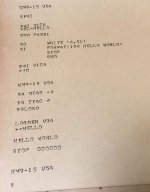m_thompson
Veteran Member
We have found that the PDP-9 format is really picky about DECtapes. You can format DECtapes in PDP-9/PDP-10 format on a PDP-8, but only about 10% of the ones that I have tried will successfully format and go through all of the checking steps. Some DECtapes are too short and go off the end of the tape. Maybe it is just that having been a PDP-8 DECtape for 50 years makes them reluctant to be changed to a PDP-9 format?
In any case, the DECtapes that format and check OK on my PDP-8/e & TD8E seem to work OK on the PDP-9. I can use a modified dumprest program to write tapes that work OK on the PDP-9.
Today I booted ADSS V5A that I sysgenned on SIMH to be configured for 8K of core. The other two TU55 drives held scratch tapes. I used the "N 1" and N 2" commands to write empty directories to the scratch tapes. I used EDIT to create a "HELLO WORLD" program in FORTRAN. That was a learning experience, and too quite a few tries, and really spins DT1 and DT2 alot. We have to use the "abbreviated" F4 compiler because our PDP-9 only has 8K of core. We got the program to compile, and even got a listing of the resulting MACRO instructions. We got stuck getting the LINKER to work. You need to enter the ALTMODE character after the program name, and it wasn't obvious how to get a VT220 to sent that character. Even then it didn't link the file and run it. That is the project for this week.
It looks like this project is finally going into the software phase. Time to get some demonstration programs running.
In any case, the DECtapes that format and check OK on my PDP-8/e & TD8E seem to work OK on the PDP-9. I can use a modified dumprest program to write tapes that work OK on the PDP-9.
Today I booted ADSS V5A that I sysgenned on SIMH to be configured for 8K of core. The other two TU55 drives held scratch tapes. I used the "N 1" and N 2" commands to write empty directories to the scratch tapes. I used EDIT to create a "HELLO WORLD" program in FORTRAN. That was a learning experience, and too quite a few tries, and really spins DT1 and DT2 alot. We have to use the "abbreviated" F4 compiler because our PDP-9 only has 8K of core. We got the program to compile, and even got a listing of the resulting MACRO instructions. We got stuck getting the LINKER to work. You need to enter the ALTMODE character after the program name, and it wasn't obvious how to get a VT220 to sent that character. Even then it didn't link the file and run it. That is the project for this week.
It looks like this project is finally going into the software phase. Time to get some demonstration programs running.

